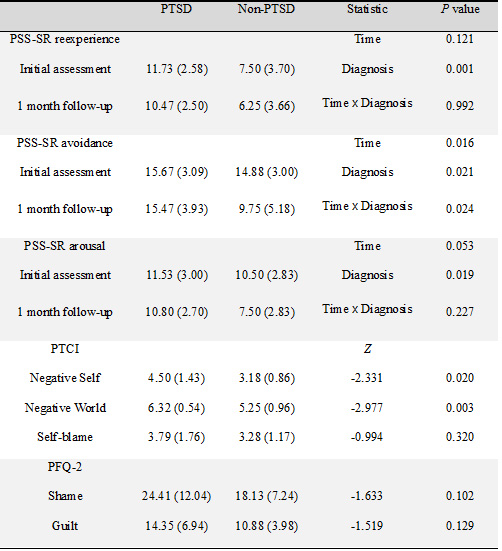2. Classen C, Field NP, Koopman C, Nevill-Manning K, Spiegel D. Interpersonal problems and their relationship to sexual revictimization among women sexually abused in childhood. J Interpers Violence. 2001; 16:495–509.
3. Deblinger E, Steer R, Lippmann J. Maternal factors associated with sexually abused children's psychosocial adjustment. Child Maltreat. 1999; 4:13–20.
4. Noll JG, Horowitz LA, Bonanno GA, Trickett PK, Putnam FW. Revictimization and self-harm in females who experienced childhood sexual abuse: results from a prospective study. J Interpers Violence. 2003; 18:1452–1471.
5. Dunmore E, Clark DM, Ehlers A. A prospective investigation of the role of cognitive factors in persistent posttraumatic stress disorder (PTSD) after physical or sexual assault. Behav Res Ther. 2001; 39:1063–1084.
6. Kilpatrick DG, Edmunds CN, Seymour AK. Rape in America: a report to the nation. Arlington: National Victim Center and Medical University of South Carolina;1992.
7. Foa EB, Riggs DS. Post-traumatic stress disorder in rape victims. In : Oldham J, Riba MB, Tasman A, editors. American Psythiatric Press review of psychiatry. Washington, D.C.: American Psychiatry Press;1993. Vol. 12:p. 272–303.
8. Foa EB, Rothbaum BO. Treating the trauma of rape: cognitive-behavioral therapy for PTSD. New York: Guilford Press;1998.
9. McCann IL, Pearlman LA. Psychological trauma and the adult survivor: theory, therapy, and transformation. New York: Brunner/Mazel;1990.
10. Resick PA, Schnicke MK. Cognitive processing therapy for rape victims: a treatment manual. Newbury Park: Sage Publications;1993.
11. Ehlers A, Clark DM. A cognitive model of posttraumatic stress disorder. Behav Res Ther. 2000; 38:319–345.
12. Tangney JP, Stuewig J. A moral-emotional perspective on evil persons and evil deeds. In : Miller AG, editor. The social psychology of good and evil. New York: Guilford Press;2004. p. 327–355.
13. Tracy JL, Robins RW. Putting the self into self-conscious emotions: a theoretical model. Psychol Inq. 2004; 15:103–125.
14. Smith RH, Webster JM, Parrott WG, Eyre HL. The role of public exposure in moral and nonmoral shame and guilt. J Pers Soc Psychol. 2002; 83:138–159.
15. Street AE, Gibson LE, Holohan DR. Impact of childhood traumatic events, trauma-related guilt, and avoidant coping strategies on PTSD symptoms in female survivors of domestic violence. J Trauma Stress. 2005; 18:245–252.
16. Feiring C, Taska L, Lewis M. A process model for understanding adaptation to sexual abuse: the role of shame in defining stigmatization. Child Abuse Negl. 1996; 20:767–782.
17. Uji M, Shikai N, Shono M, Kitamura T. Contribution of shame and attribution style in developing PTSD among Japanese University women with negative sexual experiences. Arch Womens Ment Health. 2007; 10:111–120.
18. Foa EB, Ehlers A, Clark DM, Tolin DF, Orsillo SM. The Posttraumatic Cognitions Inventory (PTCI): development and validation. Psychol Assess. 1999; 11:303–314.
19. Blake DD, Weathers FW, Nagy LM, Kaloupek DG, Gusman FD, Charney DS, Keane TM. The development of a Clinician-Administered PTSD Scale. J Trauma Stress. 1995; 8:75–90.
20. Lee BY, Kim Y, Yi SM, Eun HJ, Kim DI, Kim JY. A reliability and validity study of a clinician-administered PTSD scale. J Korean Neuropsychiatr Assoc. 1999; 38:514–522.
21. Foa EB, Riggs DS, Dancu CV, Rothbaum BO. Reliability and validity of a brief instrument for assessing post-traumatic stress disorder. J Trauma Stress. 1993; 6:459–473.
22. Han OS. Hong JP, editor. Korean version of the Structured Clinical Interview for DSM-IV. Seoul: Hana Medical Publishing Co.;2000.
23. Harder DH, Zalma A. Two promising shame and guilt scales: a construct validity comparison. J Pers Assess. 1990; 55:729–745.
24. Lee YS, Song JY. Study of reliability and validity of the BDI, the SDS, and the MMPI Depression scale. Korean J Clin Psychol. 1991; 10:98–113.
25. Kwon SM. Differential roles of dysfunctional attitudes and automatic thoughts in depression: an integrated model of depression. Queensland: University of Queensland;1992.
26. Yoo SW, Kim YS, Noh JS, Oh KS, Kim CH, Namkoong K, Chae JH, Lee GC, Jeon SI, Min KJ, et al. Validity of Korean version of the Mini-International Neuropsychiatric Interview. Anxiety Mood. 2006; 2:50–55.
27. Rothbaum BO, Foa EB, Riggs DS, Murdock T, Walsh W. A prospective examination of post-traumatic stress disorder in rape victims. J Trauma Stress. 1992; 5:455–475.
28. Perkonigg A, Pfister H, Stein MB, Höfler M, Lieb R, Maercker A, Wittchen HU. Longitudinal course of posttraumatic stress disorder and posttraumatic stress disorder symptoms in a community sample of adolescents and young adults. Am J Psychiatry. 2005; 162:1320–1327.
29. Harvey AG, Bryant RA. Two-year prospective evaluation of the relationship between acute stress disorder and posttraumatic stress disorder following mild traumatic brain injury. Am J Psychiatry. 2000; 157:626–628.
30. Beck JG, Coffey SF, Palyo SA, Gudmundsdottir B, Miller LM, Colder CR. Psychometric Properties of the Posttraumatic Cognitions Inventory (PTCI): a replication with motor vehicle accident survivors. Psychol Assess. 2004; 16:289–298.
31. Startup M, Makgekgenene L, Webster R. The role of self-blame for trauma as assessed by the Posttraumatic Cognitions Inventory (PTCI): a self-protective cognition? Behav Res Ther. 2007; 45:395–403.
32. Bennett SA, Beck JG, Clapp JD. Understanding the relationship between posttraumatic stress disorder and trauma cognitions: the impact of thought control strategies. Behav Res Ther. 2009; 47:1018–1023.
33. Harder DW, Rockart L, Cutler L. Additional validity evidence for the Harder Personal Feelings Questionnaire-2 (PFQ2): a measure of shame and guilt proneness. J Clin Psychol. 1993; 49:345–348.
34. Tangney JP, Wagner P, Fletcher C, Gramzow R. Shamed into anger? the relation of shame and guilt to anger and self-reported aggression. J Pers Soc Psychol. 1992; 62:669–675.
35. Koss MP, Gidycz CA, Wisniewski N. The scope of rape: incidence and prevalence of sexual aggression and victimization in a national sample of higher education students. J Consult Clin Psychol. 1987; 55:162–170.








 PDF
PDF ePub
ePub Citation
Citation Print
Print






 XML Download
XML Download